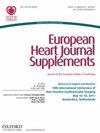以分叉罪魁病变为表现的STEMI患者侧支延期支架术
IF 1.7
4区 医学
Q3 CARDIAC & CARDIOVASCULAR SYSTEMS
引用次数: 0
摘要
在一些特殊人群中,如血管严重钙化、左主干未受保护和含血栓病变的患者,真正的分叉病变是具有挑战性的。多次充气已知会增加初次PCI期间无回流/慢流(NR/SL)的发生率。理想的分岔支架术在初级PCI仍然是模糊的策略。一些研究显示延迟支架置入术在初次PCI中有一些益处,但这一领域仍需要更多的证据。在我们的研究中,我们比较了初次PCI期间侧支延期支架置入与初次PCI期间完全分岔支架置入策略。方法:这是一项前瞻性观察性研究,纳入了因真分叉罪魁祸首病变可适用双支架技术而出现STEMI的患者。第一组包括出院前行临时支架术和延期侧支支架术的患者。第二组包括在初次PCI中采用完全双支架分岔技术的患者。所使用的技术是根据操作者的判断,而在最初设置时立即有两个支架策略指征的患者被排除在我们的研究之外。出院前主要观察指标为MACE。次要结果包括分岔技术结束时的血管造影结果。结果共60例患者符合纳入标准,平均年龄(58.69±9.61)岁,女性31.2%。26例患者接受了侧支延期支架术,34例患者在初次PCI设置时接受了完整的双支架术。初次PCI时延期支架置入组与双支架置入组相比,MACE较低,但无显著差异(21.62% vs 23.64%, P>0.01)。I组(延期支架置入术)的血管造影结果明显优于II组。关于TIMI II- iii型血流,86.2%的患者在主血管和侧支均达到,而II组为51.1%,CTFC为8.1比9.6,在I组中,78%的患者达到TMPG II- iii型,而II组为56.7%。结论原发性PCI侧支延期支架术治疗真分叉病变具有较好的血管造影效果。然而,两种策略间的MACE无显著差异。本文章由计算机程序翻译,如有差异,请以英文原文为准。
Deferred Stenting for Side Branch in STEMI Patients Presented by Bifurcation Culprit Lesion
Abstract Background True bifurcation lesions are challenging in some special populations like patients with heavily calcified vessels, unprotected left main, and thrombus-containing lesions. Multiple inflations are known to increase the incidence of no-reflow/slow-flow (NR/SL) during primary PCI. The ideal bifurcation stenting strategy during primary PCI is still obscure. Some studies have shown some benefits for deferred stenting in primary PCI but still this area needs more evidence. In our study, we compared deferred stenting for the side branch during primary PCI versus the complete bifurcation stenting strategy during primary PCI. Methods This is prospective observational study included patients who presented with STEMI due to true bifurcation culprit lesion amenable for two stents technique. Group one included patients with provisional stenting and deferred side branch stenting before hospital discharge. Group two included patients with complete two stents bifurcation technique during primary PCI. The technique used was according to operator discretion while patients with immediate indications for two stents strategy during the primary setting were excluded from our study. The primary outcome was MACE till hospital discharge. Secondary outcomes included angiographic outcomes by the end of the bifurcation technique. Results A total of 60 patients met our inclusion criteria, mean age (58.69±9.61), 31.2% women. Twenty-six patients received deferred stenting for side branch, and 34 received complete two stents bifurcation strategy at the primary PCI setting. MACE to hospital discharge was lower in the deferred stenting group without significant difference (21.62% vs 23.64%, P>0.01] compared with the two-stenting approach during primary PCI. Group I (deferred stenting) had significantly superior angiographic outcomes than group II. As regards TIMI II-III flow, 86.2% of patients achieved it in both main vessel and side branch versus 51.1% in group II, CTFC was 8.1 versus 9.6, and in group I, 78% of patients achieved TMPG II-III, compared to 56.7% in group II. Conclusion Deferred stenting for side branch in primary PCI achieved superior angiographic outcomes in the treatment of true bifurcation lesions. However, there was no significant difference in MACE between both strategies.
求助全文
通过发布文献求助,成功后即可免费获取论文全文。
去求助
来源期刊

European Heart Journal Supplements
医学-心血管系统
CiteScore
3.00
自引率
0.00%
发文量
575
审稿时长
12 months
期刊介绍:
The European Heart Journal Supplements (EHJs) is a long standing member of the ESC Journal Family that serves as a publication medium for supplemental issues of the flagship European Heart Journal. Traditionally EHJs published a broad range of articles from symposia to special issues on specific topics of interest.
The Editor-in-Chief, Professor Roberto Ferrari, together with his team of eminent Associate Editors: Professor Francisco Fernández-Avilés, Professors Jeroen Bax, Michael Böhm, Frank Ruschitzka, and Thomas Lüscher from the European Heart Journal, has implemented a change of focus for the journal. This entirely refreshed version of the European Heart Journal Supplements now bears the subtitle the Heart of the Matter to give recognition to the focus the journal now has.
The EHJs – the Heart of the Matter intends to offer a dedicated, scientific space for the ESC, Institutions, National and Affiliate Societies, Associations, Working Groups and Councils to disseminate their important successes globally.
 求助内容:
求助内容: 应助结果提醒方式:
应助结果提醒方式:


